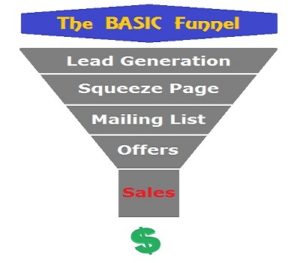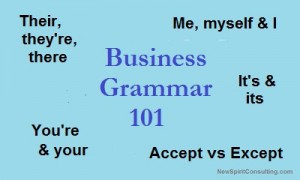Posts Categorised: Small Business
To grow your business, you need to attract new prospects, convert them into customers and get them to buy from you again and again.
When a prospect comes to your website or your store, they’ve shown an interest in your company. Now what do you do?
Sure, you can offer to sell them something. But wonder if they’re not quite ready to buy?
Why not capture their contact information so you can make your offer again? Hopefully when they ARE ready to buy.
Problem is talking them into giving you that information.
There are so many advertising messages bombarding us every day, most people are hesitant to agree to more by giving you their phone number or email.
Step One
It can be a contest entry. Or a helpful item that ties into your main product or service. Or a free sample – and, no, it’s got to be something more than the tiny taste you might get at the warehouse stores.
For example, a carpet cleaning service might offer a small e-report on the common mistakes people make that reduce the life of their carpet.
It’s got to be something they want. Something helpful and irresistible. This is a LEAD MAGNET.
Step Two
Now that they’ve given you permission to contact them, you continue to provide valuable information about your business and products or services.
Mix in an offer for something your prospect could use – whether more information or a physical product or a service.
The key is to price it as an impulse buy. It should be like the pack of gum displayed at the checkout counter – they don’t even think about the cost. This is a TRIP WIRE.
A roofer might offer gutter cleaning at a discounted rate. What better way to make a connection with a roofing prospect and get to see the condition of their roof?
The key is to convert them from a prospect into a buyer – even if what they bought only costs a few dollars – because it causes a psychological shift. They’ve opened their wallet for you. When they’ve done it once, they’re more likely to do it again.
The Trip Wire is not designed to make money, but rather to transition your prospect into a customer.
Step Three
The next step of a basic funnel is your CORE OFFER. This product or service is often designed to make something easier to do or to save the buyer time and/or money.
Sometimes they’re ready to buy and sometimes they’re not. You may need to continue providing quality information to get them to know, like and trust you enough to buy something bigger from you.
Step Four
When they do buy your core offer, you follow that with an UPSELL.
You’ve probably learned about this already when you’ve been asked, “Do you want fries with that?” This simple phrase makes millions of dollars for McDonalds every year and it works the same way for just about every other type of business.
Sometimes these upsell offers are multiple copies of the same product at a bulk discount. So instead of buying just 1 bottle of a supplement, your customer may buy 4 bottles because of the discount.
Sometimes it will be a related product. Perhaps you offer a basic candle making kit and as an upsell you offer a variety of scents to add to their candles.
Sometimes it will be a done-for-you offer. You’ve provided the steps and information to fix a problem your customer has, but maybe they don’t have the time to implement it. So, you ask, “Want help with that?”
And sometimes it’s a membership product. Columbia House was an early adopter of this type of offer. You got 6 albums for a penny and every month you would get another album shipped to you automatically.
These offers can all increase profits. Sometimes dramatically.
Each of the steps in your funnel will weed out the lookers from the buyers. If someone doesn’t buy on the first offer, you can continue to provide more information and offers.
When someone does buy, they’re moved to a different set of emails and offers.
That’s your basic funnel.
If you’d like some help designing and/or testing your funnel, give us a call today!
Is your website working as hard for you as it can? Does it show up in the search results for your service or product?
If you answered ‘No’ to either question, you probably need to optimize your website – Search Engine Optimization or SEO for short.
You can read about SEO and see if you’d like to tackle it yourself. Or you might think it would be smarter to hire a pro to help.
But how do you choose the best search engine marketing firm?
There are lots of choices. Some are good. Some can get great results, but use risky tactics. Some were good, but haven’t kept up with the latest SEM tactics. Plus there are many scam artists.
To help you out, here is a list of some warning signs.
- Be careful of a firm that mass mails. A good SEM/SEO firm is generally too busy to be sending junk mail.
- Be careful of someone who guarantees a number one ranking or even a page one ranking. Particularly if they say they can do it quickly. Although they may be able to it, most likely it will be for junk keywords. What good will it do you to rank high if no one is searching on those keywords?
- Be careful of a firm that won’t tell you how they will get you better rankings. Their ‘secret magic’ may wind up getting your website banned.
- Be careful of fake testimonials. If someone is doing work online their testimonials should include a link to the actual client’s website. I’ve seen some so shady they’ve actually included fake video testimonials that were probably made by Fiverr sellers. One ‘seo expert’ had a testimonial video from an optometrist – a profession that requires licensing – and, nope, the ‘optometrist’ is either unlicensed or just plain doesn’t exist.
- Be careful of fake or spammy backlinks. Backlinks are important for ranking well in the search engines. Recently Google cracked down on poor quality backlinks, but a technique that still works (sometimes) is creating a lot of websites and including a link from each of these sites back to the client’s website. If the content on each of these websites is original and useful, I would call that a gray-hat technique. Unfortunately that’s not always the case. I found another ‘SEO guru’ who had several backlinks from websites that looked, at first glance, to be legitimate. The sites seemed well designed with appropriate page titles and subtitles, but upon looking closer every bit of content was the sample Latin gibberish many programmers use.
- Be careful of someone who uses black-hat techniques and even some gray-hat techniques. If you decide to work with them, be sure you know the risks. Your website could move up the rankings quickly, which can be a good thing. But if it moves up too quickly or if Google suspects something shady you could lose your ranking or even disappear completely from the search results. It could even happen despite what looks like white-hat techniques used on your site, if Google can connect your site to someone who is using black-hat techniques.
Good luck with your search and remember, if it seems to good to be true, it probably isn’t.
Contact us if you’d like some help with your rankings. We’d be glad to tell you about our services and see if we’d be a good fit.
There seems to be a horrible lack in good grammar and spelling online. I’ve seen it in websites, emails and social media, but product launch materials are the worst offenders.

You may be thinking, ‘What does it matter if my customers understand what I’m saying?’
First, are you sure they understand you?
Maybe you wrote ‘through’ when you really meant ‘thorough.’ Thorough means ‘all-encompassing.’ In other words you were careful, complete, comprehensive, exhaustive, and/or meticulous. That’s very different from ‘through’ which means done. If you really meant you were done, you could have used other words such as over, completed, finished, terminated, wrapped up.
And please tell me you didn’t abbreviate it to ‘thru.’ That’s fine when you’re texting a friend, but not okay in business writing.
Second, poor spelling and grammar tells your customers that you don’t really care about them. You haven’t taken the time to be complete and correct. That can make them wonder whether the product or service you offer is also slip-shod.
Often misused words and how to use them correctly:
- There, their and they’re probably top the list of the most commonly misused words. ‘The students indicated they’re finished as they put their paperwork on the teacher’s desk over there.’
To figure it out, try substituting ‘they are’ – if it makes sense, use the contraction ‘they’re.’
If it doesn’t make sense, are you talking about possession? Try substituting the word ‘our.’ If the sentence still makes sense, use ‘their.’
Are you talking about a place? Try substituting ‘here’ for ‘there.’ It can also mean something exists, such as, ‘There are two dogs.’
- It’s and its are pretty easy to get correct. If you can substitute ‘it is’ or ‘it has’ use the contraction ‘it’s.’ Use ‘its’ for everything else.
- Your and you’re are often confused, but just as easy to find the correct one. Try substituting ‘you are.’ If it makes sense, use ‘you’re’ and if it doesn’t make sense use ‘your.’ ‘You’re mistaken in your belief that the sky is green.’
- Whether and weather are a little harder. ‘Whether’ is similar to ‘if’ – ‘I’m playing football, whether it’s raining or not.’ ‘Weather’ is about the atmospheric conditions – ‘The weather outside is frightful.’ But it can also be used as a verb meaning to withstand or endure or, to make it more complicated, to erode over time – ‘We’ll weather the storm in that bay’ or ‘The surface of the rock weathered over time.’
To make it more interesting, there is another word that sounds the same, but you probably won’t use very often. ‘Wether’ is a castrated male sheep.
- Affect and effect or accept and except sound almost identical and yet have very different meanings. These can be a little harder to figure out.
If you’re comfortable with sentence structure, effect is a noun and affect is a verb. Some people use the phrase ‘Affect the Effect’ – in other words something happened (affect) that caused a consequence (effect). You can try substituting ‘consequence’ and if the sentence still makes sense, use ‘effect.’ Otherwise ‘affect’ is probably correct.
- Accept and except are also different types of words. Accept is a verb and except can be a preposition, a conjunction or sometimes a verb. No wonder these words are so often confused! Accept means to receive something. Perhaps the easiest tip I’ve heard is to remember ‘EXcept’ means to EXclude something and Accept means to Add something. ‘He accepted the Academy Award’ or ‘I don’t like lawyers, present company excepted.’
Me, myself and I
Another of my pet peeves is the incorrect usage of me, myself and I. For some reason people are afraid to use the word ‘me’ and stick ‘myself’ in there where it doesn’t belong. Generally speaking, if you’re trying to emphasize your role in something and have already used the word ‘I’ in your sentence, you can add ‘myself’ – ‘I kept half the loot for myself.’ Otherwise don’t use it.
‘Me’ and ‘I’ tend to get confused when you’re talking about you and another person. To make it easy, drop the other person from the sentence. If ‘Barbara gave a present to I’ doesn’t sound right, then don’t say ‘Barbara gave a present to my wife and I.’ It should be ‘Barbara gave a present to my wife and me.’ If ‘Me wrote the play’ doesn’t sound right, then ‘Jim and me wrote the play’ is wrong as well. And, no, that doesn’t mean you can stick ‘myself’ in there. The correct sentence would be ‘Jim and I wrote the play.’
Quotes and sayings
More problems occur when someone tries to quote a familiar saying and gets it wrong. Recently I was reading some marketing material from a large, well-known company and a phrase – ‘take the reigns’ – brought me to a screeching halt. The correct phrase is ‘take the reins.’ Reins are the leather straps the stagecoach driver uses to control the horses in old western movies.
The writer was trying to say their customers should be in control – thus ‘take the reins’ – but got confused with the word ‘reign’ which means royal rule or authority. Sounds reasonable, but still incorrect.
Here is a post about the difference between rein and reign. Unfortunately the mistake has become commonplace so people are accepting the mistake rather than correcting it.
And please tell me you’ve never used the word ‘rain’ – meaning water that falls out of the sky – in this old saying. I hope it’s clear why it would be incorrect.
Also if you’d like to learn about the origin of some phrases, such as bite the bullet or spill the beans, check out this website.
So how do you fix these faux pas?
Look it up! Here is a very helpful website – http://dictionary.reference.com/
Another option is to use a program such as Microsoft Word to check your spelling and grammar. But remember it is just a tool and there may be times when you won’t accept the suggestions. For example, some product names use creative misspellings. Or maybe you want to write more creatively, such as in the Hemingway style. In the dark. In the rain. Yep, those phrases would be flagged because they aren’t complete sentences.
There are times to break the rules, just make sure you’re not breaking the rules because you’re too lazy to check correct usage first.
If you want to go a step further, try using the thesaurus to find similar words. Remember the list above – comprehensive, exhaustive, meticulous? Those are synonyms for the word, ‘thorough.’
To make your writing really sparkle, try looking up a few words to see if there’s a synonym that more completely expresses your feeling and use it instead. Just don’t go overboard and make your writing hard to understand.
Microsoft Word has a thesaurus function or you can try http://www.thesaurus.com/ to look up a word.
Now that you know my pet peeves, what words or phrases make you think of fingernails on a chalkboard?
Getting some serious love for your company’s tweets can be a bit of a challenge. After all, you have to fit a lot in a tiny space.
However with a lot of creativity and a dash of luck you can whip up some lip-smacking tweets. Here are three of my picks for the ‘Best Use of Twitter by a Big Brand.’
First, we have Starbucks. Now people who know me well would wonder why I’ve included coffee in my ‘best’ list. You see, I’m allergic to coffee. I can’t even walk down the coffee aisle in the store without sneezing. But it’s such a great idea; I just had to include them.
Most companies use Twitter to tell their fans about their products or services. They might talk about features or upcoming sales, but how many actually sell their product online, instantly? Remember, we’re talking coffee here.
Starbucks had a great idea. Customers could connect their Starbucks and Twitter accounts to send gift cards to friends.
Need a birthday gift? Tweet a gift card. Want to say ‘I’m sorry’ to your sweetie? Tweet another card.
Over 27,000 people tweeted coffee to their friends and had the cash registers ringing to the tune of $180,000.
Good thing no one thought to tweet some to me. Achooo!
That was a well-planned campaign, but sometimes being in the right place, at the right time leads to something great.
Now you don’t normally think of Arby’s Restaurant and the Grammy Awards in the same sentence, but by being ready for anything Arby’s was able to get a bit of the limelight.
Arby’s uses Tweetdeck to listen for any mention of their brand name and when someone tweeted that Pharrell Williams’ hat looked like the Arby’s logo, Arby’s jumped in – ‘Hey @Pharrell, can we have our hat back?‘
Of course, the tweet got lots of attention and the conversation continued over the next several weeks whenever Pharrell wore the hat in public. Eventually he listed the hat on eBay and sold it for over $44,000 – to Arby’s – who donated the money to charity.
Although it wasn’t planned, the Arby’s team was ready for any mention of their brand. I imagine the bean counters were pretty happy as they estimated that amount of engagement from paid advertising would have cost somewhere around $22 million.
Good catch, Arby’s!
The third campaign was carefully planned, but with built-in flexibility to take advantage of whatever happened.
Advertising during the Super Bowl is super expensive and competing for attention during the game is super hard – action on the field, action around the TV, food, commercials…
Cutting through all that noise was a little tweet – ‘Who kkmew theis was ghiong tob e a baweball ghamle.’
Yep, it got noticed.
Everyone thought someone at JCPenney was drunk. Not really unusual during the Super Bowl, but using the company’s Twitter account? Somebody’s head was going to roll.
JCPenney waited a bit to gauge the reaction, then tweeted once more – ‘Toughdown Seadawks!! Is sSeattle going toa runaway wit h this???’
This was a marketer’s dream. It went viral.
Almost half-hour later JCPenny tweeted again – ‘Oops… Sorry for the typos. We were #TweetingWithMittens.’ This time they included a picture of knitted mittens holding a smart phone. These mittens had a logo – ‘Go USA’ – in preparation for the Winter Olympics.
Three tweets, timed right, and a bit unexpected, turned into thousands of new followers, lots of media coverage and massive sales on mittens.
Touchdown JCPenney!
So, put your thinking cap on and see if you can come up with something useful, clever and maybe a little unexpected for your brand.





